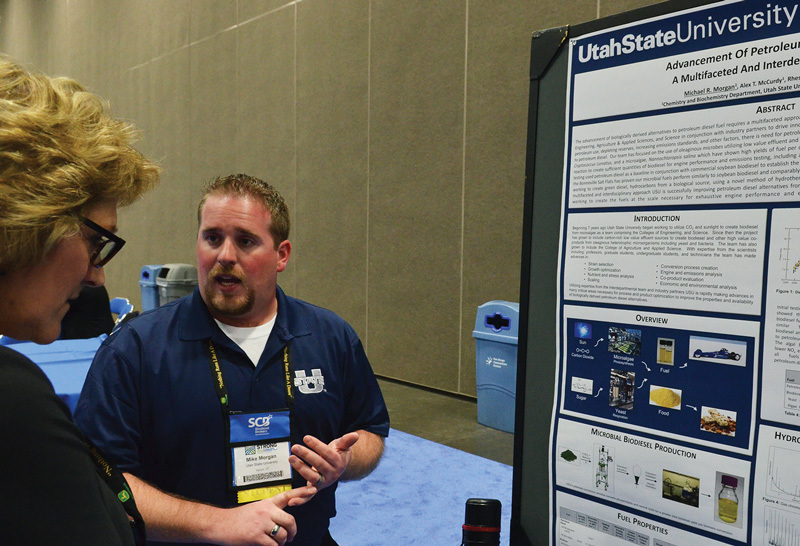The Next Generation Adds to Biodiesel Sustainability and Growth



March 4, 2014
BY Don Scott
When National Biodiesel Board CEO Joe Jobe addressed the biodiesel industry at the recent conference in San Diego, he reminded us of the importance of history in understanding how we got to where we are. The history of the U.S. biodiesel industry can be traced back to a university laboratory—actually at my alma mater, the University of Missouri-Columbia.
Just as our roots are in scientific research, as biodiesel grows and adapts to our changing energy landscape, the future of the industry also lies in what science can produce. Undoubtedly laboratories at academic institutions will continue to shape the science that defines us. That is why NBB initiated the Next Generation Scientists for Biodiesel program in 2010.
During the National Biodiesel Conference & Expo in January, we were honored to have 36 young scientists attending as part of this program. For the first time, we hosted a student-led breakout session, and we are fortunate to share in some of their research. These bright students have projects ranging from developing improved fuel quality test methods to enhancing the efficiency of biodiesel production and coproduct utilization. They also have numerous projects exploring new feedstocks, including soybean yield improvement, explorations into lipid-producing algae and microbes, and processing trap grease into biodiesel.
I congratulate these young scientists for exploring untested methods, some of which may be perfected to bring more biodiesel to market in the future. The biodiesel industry would be nothing without the open minds of scientists looking for better solutions.
In the political sphere, there seems to be a battle between the open minds, pursuing better energy policy, and the limited thinkers who can’t escape the status quo. It’s a battle between science and the pseudoscience conjured by those who want to keep us addicted to oil, or perpetuated by those who think we will always be limited by feedstock.
Many of the student scientists have now dipped their toes into these political waters, coming to biodiesel’s defense in January by submitting comments to the U.S. EPA about the proposed cuts to the federal renewable fuel standard. In addition, the four co-chairs of NGSB submitted original comments to EPA, saying, “We see your support as an investment in our future. As scientists, we can contribute to the sustainable growth of biodiesel and make it an even more valuable product for the nation’s fuel supply….Our greatest hope is that the United States will remain the top producer of biofuels among any country, consistent with our tradition of excellence, creating opportunities for youth, and leading the world by example.”
The biodiesel industry is evolving, becoming more diverse and more efficient. Growth fosters these changes. We can’t say exactly how much biodiesel we can produce in 2030 or beyond, but it’s safe to say that it will be significant—if our progress continues. We’ve already met our goal to produce 5 percent of U.S. diesel fuel volumes ahead of our 2015 target. Now our sights are set on 10 percent by 2022. Implicit in these goals is that we grow sustainably according to feedstock availability. Responsible growth incentivizes the development of more feedstocks and more effective utilization of existing feedstocks. Our industry track record proves that we are good at setting responsible goals for biodiesel volume growth. While setting those goals requires some balance between overreaching and stagnation, we cannot overreach when it comes to investing in science.
When early U.S. biodiesel research began a little more than two decades ago, some of the student scientists we met in January hadn’t even been born. Yet they are the ones who will lead us down the path to exploring every available option. Each of them has the potential to discover successful breakthroughs, like those who have brought us to where we are today. Someday, they will take us to the next generation of biodiesel.
Don Scott, Director of Sustainability, National Biodiesel Board
Advertisement
Advertisement
Related Stories
U.S. farmers are expected to plant 83.5 million acres of soybeans in 2025, down 4% when compared to last year, according to the USDA National Agricultural Statistics Service’s annual Prospective Plantings report, released March 31.
ADM and Mitsubishi Corp. on March 27 announced the signing of a non-binding memorandum of understanding (MOU) to form a strategic alliance to explore potential areas of future collaboration across the agriculture value chain.
China’s exports of used cooking oil (UCO) reached a record high in 2024 but fell sharply in December after the Chinese government eliminated the 13% export tax rebate for UCO, according to a report filed with the USDA.
Ash Creek Renewables expands global reach with exclusive camelina seed licenses and 'Forks and Fuels' initiative
Ash Creek Renewables, a portfolio company of Tailwater Capital LLC, on March 20 announced it has secured exclusive licensing rights from Montana State University for a new high-performance camelina seed variety.
Clean Fuels Alliance America on March 18 submitted comments supporting USDA on its Technical Guidelines for Climate-Smart Agriculture Crops Used as Biofuel Feedstocks Interim Rule and incorporation of USDA FD-CIC.
Upcoming Events










